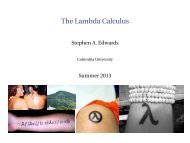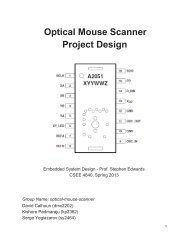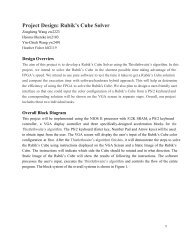Verilog and SystemC - Columbia University
Verilog and SystemC - Columbia University
Verilog and SystemC - Columbia University
Create successful ePaper yourself
Turn your PDF publications into a flip-book with our unique Google optimized e-Paper software.
occurrence of a specified event. As Edwards [1]<br />
points out, hardware does not exhibit this<br />
behavior, but such processes can be useful when<br />
designing a test bench.<br />
Synchronous threads are a special case of<br />
threads, where triggering takes place at a specific<br />
edge of a signal. The scheduling of all three<br />
process types takes place at the bottom portion of<br />
a <strong>SystemC</strong> model, by using the sc_ctor() macro<br />
(<strong>SystemC</strong> constructor). In modeling an alarm<br />
clock controller, such a constructor was called for<br />
the tick process of type method:<br />
sc_ctor ( Runner ) {<br />
sc_method ( tick );<br />
sensitive_pos ( clock );<br />
}<br />
where Runner is the name of the sc_module that<br />
owns the tick process.<br />
<strong>Verilog</strong> per se does not differentiate among<br />
processes, but allows flexibility to mimic the<br />
behavior found in the three scenarios described<br />
above. This is achieved by means of timingoriented<br />
constructs such as:<br />
always @ ( condition )<br />
Here the condition may be a signal or an<br />
event, in which case the identifier will be found<br />
between parentheses. By this token, a function<br />
can also be edge-triggered:<br />
always @ ( posedge clock )<br />
As strongly-typed languages, both <strong>Verilog</strong> <strong>and</strong><br />
<strong>SystemC</strong> support signals as well as variables. They<br />
do differ in the built-in types available to the user.<br />
<strong>Verilog</strong> subdivides its data types into two main<br />
categories: registers <strong>and</strong> nets. A register type<br />
involves storage <strong>and</strong> consists of the following<br />
variants:<br />
reg<br />
integer<br />
time<br />
real<br />
unsigned variable of any bit size<br />
signed 32-bit variable<br />
unsigned 64-bit variable<br />
double-precision floating point<br />
wire or tri Simple interconnecting wire<br />
wor or trior Wired outputs OR together<br />
w<strong>and</strong> or tri<strong>and</strong> Wired outputs AND together<br />
tri0<br />
Pulls down when tri-stated<br />
tri1<br />
Pulls up when tri-stated<br />
supply0 Constant logic 0 (supply strength)<br />
supply1 Constant logic 1 (supply strength)<br />
trireg Stores last value when tri-stated<br />
(capacitance strength)<br />
In order to support modeling at different levels<br />
of abstraction, from the functional to the registertransfer<br />
level, as well as to support software,<br />
<strong>SystemC</strong> provides programmers with a rich set of<br />
signal types. This is different from languages like<br />
<strong>Verilog</strong> that only support bit-vectors as types.<br />
<strong>SystemC</strong> can implement both two-valued <strong>and</strong><br />
four-valued signal types, which add practicality to<br />
a simulation.<br />
<strong>SystemC</strong>’s set of data types is enhanced to<br />
support multiple design domains <strong>and</strong> abstraction<br />
levels. The fixed precision types allow for fast<br />
simulation. The arbitrary precision types can be<br />
used for computations with large numbers <strong>and</strong> to<br />
model large busses. Such types do not have a<br />
limitation in size.<br />
In addition, this HDL provides a large<br />
selection of overloaded operators, quantization <strong>and</strong><br />
overflow modes, as well as type conversion<br />
mechanisms.<br />
<strong>SystemC</strong>, extends C++ types by utilizing the<br />
following signal definition syntax:<br />
sc_signal < base_type > signal_name;<br />
where base_type corresponds to one of C++’s<br />
base types, such as integer, real, char, etc.<br />
Likewise, ports are declared with the same syntax,<br />
but utilize the identifiers sc_in, sc_out or<br />
sc_inout.<br />
As in C or C++, a <strong>SystemC</strong> description can<br />
include user-defined libraries containing functions<br />
<strong>and</strong> data structures, to employ throughout a<br />
program. <strong>Verilog</strong> offers no such reusability<br />
feature, which in certain cases can be a drawback.<br />
This is mainly due to the language’s interpretive<br />
nature.<br />
Nets (or wires) are of a larger variety:







